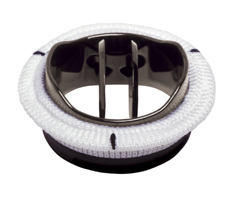Surgeon Q&A: Are Coumadin Requirements Being Lowered for On-X Mechanical Valve Replacements?
By Adam Pick on March 6, 2014
As we have learned together, there is no “perfect” valve replacement for patients who cannot have their own valves repaired. That said, as patients, we must weigh the pros and cons of each valve type – pig, cow, horse and mechanical – to determine which device is best for us given factors including age and lifestyle.
The mechanical valve replacement is an interesting choice for patients. It’s been around for over 40 years. It’s the most durable valve comprised primarily of a special form of carbon— pyrolytic carbon—that can last more than 100 years with the pressures inside the heart. And, there is some research, which suggests that patients who receive mechanical valves have lower complications over a 25-year period.

However, there are two disadvantages for mechanical valve recipients. First, some patients complain that mechanical valves “click” loudly inside the body – which can be annoying. Second, all patients who receive a mechanical valve must take anticoagulants (blood thinners) to prevent the risk of blood clots forming on the valve – for the rest of their lives.
For some patients, the thought of permanently being on blood thinners is just too much handle. As a result, some patients choose a tissue valve and risk the possibility of a future re-operation when their pig, cow or horse valve fails. But mechanical valves sometimes need to be removed from rare incidences of infection or clots.
New Study Lowers Blood Thinner Usage For On-X Mechanical Valve Patients
Interestingly… On January 14, 2014, we learned that a special type of mechanical valve, known as the On-X Plus 1.5™ Aortic Heart Valve, received an expanded CE mark in Europe which reduced the requirement of blood-thinners for patients. This important announcement was made after interim results from the PROACT trial were made public.
To better understand the implications of this study, I contacted Dr. Marc Gerdisch. As many of you know, Dr. Gerdisch is a heart valve surgeon in Indianapolis, Indiana who has successfully treated many patients in our community — including Pamela Hudson, Angie Gregory and John Siamas – at Franciscan St. Francis Health Heart Valve Center.
Dr. Gerdisch Says…
Here are the highlights from my discussion with Dr. Gerdisch:
Adam: Dr. Gerdisch, thanks so much for taking the time to help educate our community about this exciting development regarding the On-X mechanical valve.

Dr. Gerdisch: Adam, thank you for bringing this news to members of your community.
Adam: To start, can you tell us about your experience with the On-X mechanical valve in your practice? Which type of patients typically receive the valve? Why do those patients request the valve? How has the On-X valve performed in your patients?
Dr. Gerdisch: Whenever possible, if a heart valve can be spared or repaired, we do so, but if replacement is necessary, we offer patients the most advanced technology with decision making supported by the scientific literature. At Franciscan St. Francis Health Heart Valve Center in Indianapolis, we have been using the On-X mechanical valves since I came here in 2006 and have implanted more than 225, which represents about 20% of our valve replacements. They are the only mechanical valves I have implanted for over a decade. The On-X valves are designed with breakthrough technology that causes less blood cell damage than traditional mechanical valves and are the only valves with a pure carbon coating. At the blood cell level, it is a smoother surface. In 2013, our team was first in the nation to implant the On-X Aortic Prosthetic Valve with Anatomic Sewing Ring, which is the first to address the important concern of distorting the adjacent structures within the heart, by matching its contour.
The average age for the patients receiving the On-X valve is 53 years. Any patient under 65 years old will typically consider the On-X valve, to avoid the potential for tissue valve deterioration. There is important evidence that younger patients requiring valve replacement benefit from receiving a mechanical valve. The decision of a tissue vs. On-X valve is based on the patient’s likelihood of longevity, risks for anticoagulation (blood thinner) and personal preferences.
Patients have come to us seeking the On-X valve. We have been one of the leading enrollers in the PROACT Trial, the study that demonstrated lower complication rates for patients managed with lower dose anticoagulation when the On-X aortic valve was implanted. It led to European clearance for patients to be treated with the lower dose warfarin target range. Data for a similar evaluation for the mitral On-X valve is presently being accumulated. When patients research prosthetic valves, they will encounter information on the On-X valve and consequently ask for it by name.
Dr. Jack Bokros Ph.D. designed the On-X valve and is the originator of the modern bi-leaflet mechanical valve. He was involved in the development and design of all of the predecessor bi-leaflet mechanical valves, including St. Jude, Carbomedics and ATS. I have the privilege of knowing Dr. Bokros and being familiar with the progression of his scientific achievements. In addition to creating a pure carbon coating for the On-X valve, he also built it to mimic the dimensions of a native valve and to allow complete vertical displacement of the leaflets and therefore laminar (non-turbulent) blood flow. In addition, each leaflet has two points of contact at closure and the valve is typically quieter than others.
Adam: Can you expand on the PROACT study which led to CE labeling for the Aortic 1.5 Aortic Heart Valve to be managed with lower anticoagulation in Europe?
Dr. Gerdisch: The PROACT trial has three test groups and three corresponding control groups. A limb of the study designated as “high risk aortic” included patients with conditions putting them at risk for trouble with blood clots. These patients were randomized to being managed with either lower dose warfarin (INR 1.5-2) or standard anticoagulation (INR 2-3). The expanded labeling in Europe comes from this limb of the study. It found no difference in the stroke rate between lower and standard anticoagulation but showed a 60% reduction in the bleeding rate for patients on the lower anticoagulation regimen. This is a great finding for future aortic valve patients and all of those who currently have the On-X valve.
Adam: Why is this important for patients?
Dr. Gerdisch: Patients need to be fully informed of the scientific data available regarding prosthetic valve choice. There has been some progress in the performance of tissue valves, but nothing that demonstrates significant improvement in longevity. The idea that young people can receive a tissue valve with the same long-term risk as a mechanical valve lacks foundation. We now perform trans-catheter valves (TAVR) for high-risk patients, and it is possible to implant a TAVR in a previously implanted tissue valve, but we have no evidence that it will provide a low risk, durable result. Clearance of the On-X valve for lower anticoagulation in Europe is based on a statistically significant data demonstrating better outcomes for patients with less aggressive anticoagulation. It brings us closer to providing patients with an even safer and more appealing option. Of course, I will implant whatever valve a patient might choose. I make a point of reviewing all of the current options with my patients and ensuring all of their questions are answered. We then proceed with a plan we have developed together.
Adam: Why is this important for surgeons, like yourself?
Dr. Gerdisch: The On-X valve has performed remarkably well in my practice. As part of our multidisciplinary heart valve center, a cardiologist specializing in valve disease and echocardiography performs a detailed study of the valve in the operating room at the conclusion of the operation and regularly in follow up. This group of specialists gives me continuous feedback on the superb hemodynamics and lack of complications achieved with the On-X valve. Their satisfaction reflects the superior outcomes experienced by our patients. Perhaps most important is the regular updates I receive from patients fully engaged in their active lives.
Adam: Is it likely that this reduced blood thinner requirement will take effect in the United States? If so, when?
Dr. Gerdisch: I know that the company has submitted the results to the US Food and Drug Administration for review. They are hoping for approval soon for this indication.
Adam: Is it possible that, in the future, patients may not need any blood thinners with mechanical vales?
Dr. Gerdisch: This is indeed a big question. When we talk about “blood thinners” are we including all agents used to prevent blood from clotting? There are many drugs referred to as “blood thinners”, that cause the clotting time to be increased by interrupting the clotting cycle at one point or another and therefore provide some protection for implanted devices, including coronary stents. Currently we are restricted to warfarin as the “blood thinner of choice” for implanted valves, but with improved technology, we may someday be able to use other drugs.
The majority of people taking blood thinners have arrhythmias or other conditions that require protection from clotting. In fact, about 30% of people with implanted tissue valves need warfarin on a long-term basis due to these other conditions. We have focused on moving as many of our patients as possible to self-testing for their warfarin. There is superb data revealing a dramatic reduction in complications related to warfarin for patients who self-test. In other words, they have a small machine at home that allows them to check their INR. As a result their levels are easier to manage and more tightly regulated.
I hope this helped you learn more about this exciting development specific the On-X mechanical valve replacement device. On behalf of our patient and caregiver community, I would like to extend a special thanks to Dr. Marc Gerdisch for sharing his clinic experience and research with all of us.
Keep on tickin!
Adam
|
Linda Cameron says on March 7th, 2014 at 9:27 pm |
|
I have the On-X valve and age 52. Does this new study mean I no longer need to take warfarin? I will discuss this with my Dr., but wanted your take on it too. |
 |
|
Andrew says on March 11th, 2014 at 3:58 am |
|
I am 53, had mitral valve replacement with an ON-X valve in 2009. I live in the UK and my INR was reduced to be between 2.5 and 3.5 (it used to be 3 to 4). Your article only mentions aortic valve warfarin levels. Could you provide details of what the new European guidelines are for ON-X mitral valves? Many thanks Andrew Wrigley |
 |
|
John O'Neill says on March 11th, 2014 at 8:09 pm |
|
I am 62 years old and have had a Sorin Carbometics mechanical valve for almost five years. Sometimes, if it is very quiet, other people can hear it within five feet of me. After five years though, I have to concentrate to hear it in the morning when I try to get my resting heart rate. I also self test and it has really helped me to understand how to set my dosage for my present diet. I really like my leafy green vegetables and dose accordingly. My range is 2.5-3.5 and I bounce from top to bottom of my range sometimes, but always stay within it. My surgeon recommended the mechanical valve because I run marathons and do triathlons and he figured I would wear out a tissue valve in no time. I am also a full time farmer. |
 |
|
Pamela Hudson says on March 12th, 2014 at 7:03 am |
|
I am 49 years old and November 1, 2012 I received the On-X mechanical valve. Placed by Dr. Marc Gerdish. First I want to say I feel wonderful and more active then I had been in years. There are very few times that I hear my valve. So I find it to be quiet. One of the main reasons I was glad to receive the On-X mechanical valve is the hopes that someday I will not have to take Coumadin or at a lesser amount. I do self-test and I believe that anyone on Coumadin needs to self-test. I do good keeping my numbers between 2-3 but at times when I think I have stayed consistent in my diet with no changes in medications, I find that I may be high or low and that concerns me. Especially if I have to wait a month to test at a lab.So I am very excited about this study. Thank you again Dr. Marc Gerdish for all that you have done for me and continue to do for heart patients. |
 |
|
Karl L says on March 12th, 2014 at 4:34 pm |
|
I had an On-X aortic valve placed in 2009 and have been in good health since, bicycling almost every day, 10,000+ km since my surgery. If anyone else is confused about the On-X marketing this under a new name, the “On-X Plus 1.5(tm) aortic valve”, I sent them an e-mail to ask if the lower range, once approved, would also apply to my valve. The answer is fortunately YES ..! (but first it has to be approved by the FDA, and then if ever, my health care provider). |
 |
|
Mark Howie says on March 12th, 2014 at 5:45 pm |
|
I have 2 onyx valves and a ring made from the carbon. Aortic and mitral. I got the as a result of endocarditis. I had mine done at UNiversity of Alabama Birmingham in 2011. Other than the loud ticking after lunch, I guess I’m ok. I home test my INR weekly with Coagucheck. I’m a 2.5-3.5 kinda guy. |
 |
|
Dr Marc Gerdisch says on March 13th, 2014 at 1:09 pm |
|
Linda, Andrew, John, Karl, Mark, I had a bit of time today to write in on the comments. I am very pleased to be part of this community. I may not have the same opportunity to respond in the future, but please continue to post, as your questions and comments contribute to the knowledge of everyone visiting. |
 |
|
Bill Gentile says on March 13th, 2014 at 8:32 pm |
|
Great article, great support and follow – thank you to both Adam and Dr. Gerdisch. I am 44 years old and love my outdoor sports. This article (and comments above) made me realize that, being very active, that could shorten the life of a tissue valve, and thus provide another reason to go mechanical. |
 |
|
Dr Gerdisch says on March 14th, 2014 at 7:08 pm |
|
Bill, The flow through the OnX valve is as laminar as can ever be accomplished. The flair at the base of the carbon cylinder and the vertical displacement of the leaflets ensure it. The sound a valve makes is not a function of turbulence. The OnX is quiet because each leaflet sets down at 2 points. Also, because of the height of the housing, the leaflets need to travel less distance to close. In the case of BAV, if the aneurysm is the primary problem, we sometimes spare the valve. Your own well functioning BAV can provide the lowest risk scenario. As you know, valve surgery has a complex decision making process. |
 |
|
georgette madi says on March 19th, 2014 at 9:55 am |
|
hi my name is georgette i am 75 years old, my doctor recomended a heart valve replacment my aerotic valve is 0.6 cm squared and 47 mmHg should i do the operation or not when all the other things with my heart are normal everything else |
 |
|
Kelly says on February 14th, 2017 at 10:29 pm |
|
Had on x valve 2 years ago been taking 81mg aspirin daily .cardiologist said aspirin not necessary won’t affect inr . What is your recommendation |
 |












